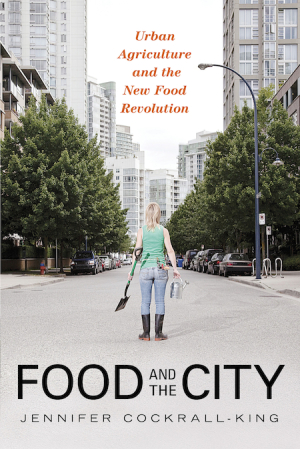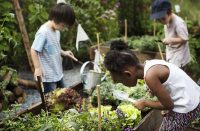Huge supermarket chains appear to be bursting at the seams with food choices, but this is mostly an illusion. The reality is that 75 per cent of our crop biodiversity has been lost. Our industrial food system has created too many overweight, undernourished citizens. The environmental degradation caused by multinational-scale agriculture is unprecedented, and we have become disconnected from what we eat.
Huge supermarket chains appear to be bursting at the seams with food choices, but this is mostly an illusion. The reality is that 75 per cent of our crop biodiversity has been lost. Our industrial food system has created too many overweight, undernourished citizens. The environmental degradation caused by multinational-scale agriculture is unprecedented, and we have become disconnected from what we eat.
Yet not all of the news is bad, says Jennifer Cockrall-King. In Food and the City, the award-winning, widely published food journalist finds inspiration in the state of urban agriculture and squares it with the growth of food production and distribution to large urban centres since the turn of the century.
By 2008, for the first time in human history, more people lived in cities than in rural areas. To illustrate and emphasize the importance of urban agriculture to our current and future well-being in light of this fact, Cockrall-King takes readers on a farming tour of diverse, solution-driven cities such as Detroit, Paris and Vancouver. Urban agriculture is one part of what Cockrall-King calls the “New Food Movement,” which puts production back into the hands of consumers and adapts to the unique needs and constraints of each built environment.
Innovation is essential to getting the best yields out of the concrete jungle, but it can sometimes seem deceptively simple. For the past five years, a Toronto-based NGO called Not Far From The Tree has been trying to make the most of the abundant fruit that grows on the city’s trees each summer. Many apples, peaches, cherries and berries that grow in Toronto have long gone to waste by falling on the ground and rotting. In 2010, the organization’s harvesting team collected more than 13,300 kilograms (29,397 pounds) of fruit. The organization’s volunteers, local food banks and the landowners who volunteered their fruit trees for the project split the harvest into thirds. Because Not Far From The Tree’s model offers fresh, tangible goods and supports a range of local stakeholders (including an important charity), the program is now being replicated in cities all over North America.
While Cockrall-King examines multiple approaches and locales of notable urban agriculture initiatives, and examines various urban production methods globally, not every increase in agricultural efficiency is easily embraced. Humans are not the only ones who have become industrial-scale eaters. The animals we eat have been forced to do so as well.
Food in the City identifies the grim realities of “Concentrated Animal Feedlot Operations” – areas where animals are raised without an existing food source and must live on agriculturally produced feed – as one of the chief villains of industrial food production. Beyond the basic feasibility of supply, mitigating the consequences of adopting this highly processed, meat-focused system on a global scale is becoming increasingly difficult. The resulting problems include new strains of antibiotic-resistant bacteria, unethical treatment of animals and more food being used to feed animals consumed by the planet’s wealthiest people rather than alleviating the poverty of its hungriest.
Cockrall-King ably profiles how we can improve our diets and reduce our environmental impact with a range of examples, from growing food in small spaces to biodynamics to small plot intensive farming (aka SPIN). Food and the City serves as a great starting point for anyone interested in alternative food systems, weaving together important milestones in urban farming, key figures in its growth and seminal texts on the subject.
This book isn’t a how-to manual, but it does provide a long list of resources to help get you started. Whatever your personal approach to growing, raising, foraging or finding your own food within city limits, this enjoyable resource will offer a boost of inspiration to eat better.
Food and the City: Urban Agriculture and the New Food Revolution, Jennifer Cockrall-King, Prometheus Books: Amherst, NY, 2012, 372 pages
Subscribe now to get more book reviews in your mailbox!
Reviewer Information
Jenn Marshman is an environmentalist who has worked in the health care industry since 1998. She is currently studying geography and environmental management at the University of Waterloo.













